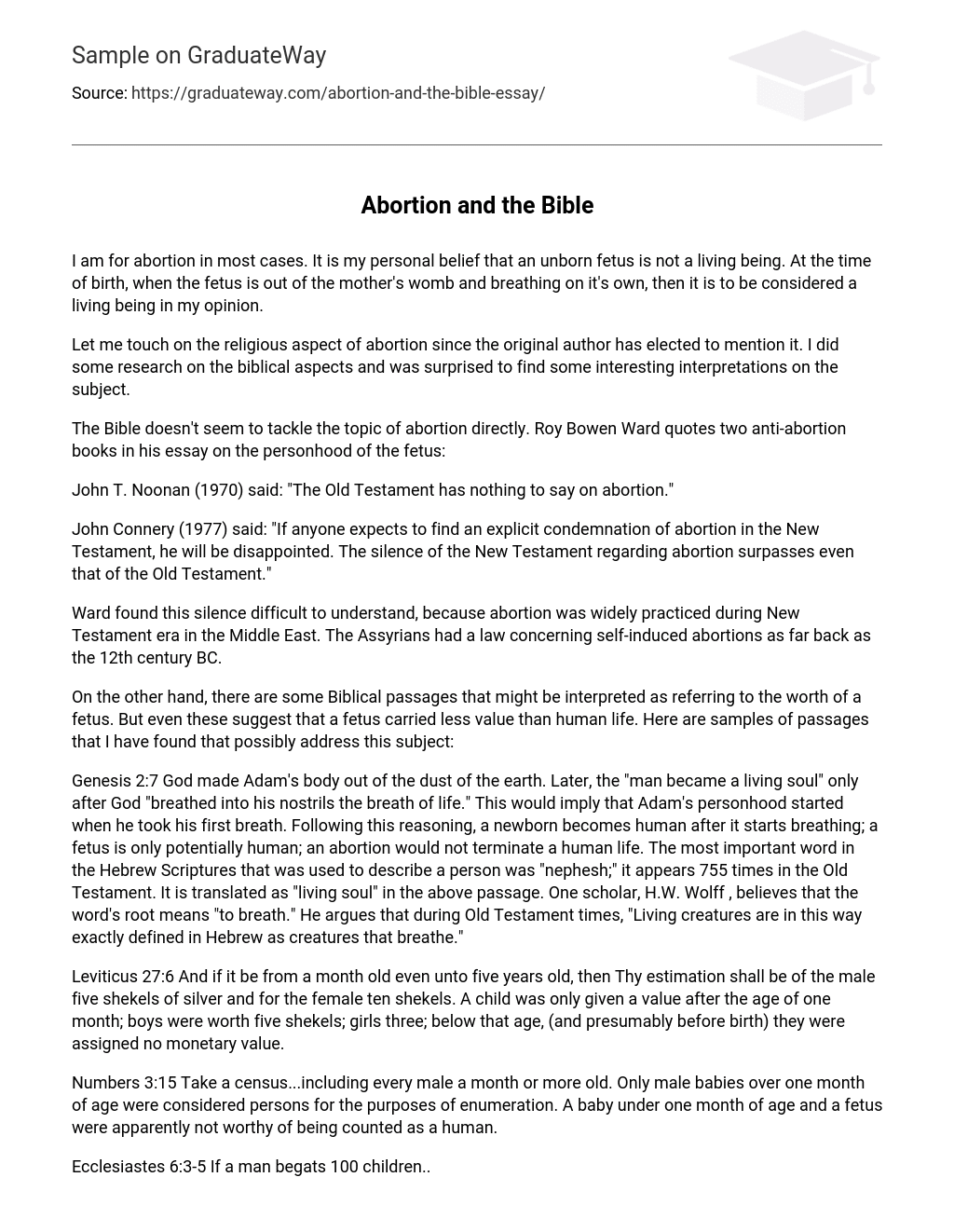From my point of view, I support abortion in most cases because I do not consider an unborn fetus to be a living entity. However, once the fetus is born and can breathe on its own outside of the mother’s womb, it should be acknowledged as a living being.
Regarding abortion, I would like to address the religious aspect mentioned by the original author. Through my research on biblical aspects, I have discovered some intriguing interpretations regarding this issue.
In his essay on the personhood of the fetus, Roy Bowen Ward contends that the Bible does not explicitly address abortion. To support his claim, he references two books opposing abortion.
According to John T. Noonan, in 1970, the Old Testament does not address the topic of abortion.
According to John Connery (1977), the New Testament does not explicitly condemn abortion and discusses it with even less emphasis than the Old Testament.
Ward found it difficult to understand why abortion was not openly discussed, given its frequent occurrence in the Middle East during the New Testament era. Historical records reveal that laws regarding self-induced abortions among the Assyrians can be traced back as early as the 12th century BC.
Although certain Biblical passages acknowledge the significance of a fetus, they also suggest that it is of lesser worth compared to human life. Here are several chosen excerpts addressing this matter:
Genesis 2:7 states that God created Adam’s body from the earth, but it was only when God breathed life into his nostrils that Adam became a living soul. This implies that Adam’s existence began with his first breath. Similarly, a newborn baby attains full humanity upon taking its first breath, while a fetus holds potential for humanity. Hence, terminating a pregnancy through abortion does not mean ending a human life. In the Old Testament, the Hebrew term “nephesh” referred to an individual and appeared 755 times. In this passage, it is translated as “living soul.” Scholar H.W. Wolff suggests that the root of this word indicates “to breathe.” According to Wolff’s interpretation, ancient Hebrew society classified creatures capable of breathing as living beings.
Leviticus 27:6 specifies that children aged one month to five years have an estimated value of five shekels for males and ten shekels for females. This verse implies that children were not given a monetary worth until they reached one month old. Boys were valued at five shekels, while girls were valued at three shekels prior to this age and possibly even before birth.
The Bible passage Numbers 3:15 instructs to conduct a census that includes all males who are one month or older. According to this passage, only male infants who were older than one month were regarded as individuals for the purpose of counting. Infants under one month old and fetuses were seemingly not regarded as deserving to be included in the human count.
According to Ecclesiastes 6:3-5, having a hundred children but lacking fulfillment and a proper burial would make a man consider a miscarriage preferable. This passage implies that even if someone has many children and lives a long life, it is better to be born dead than to live without love, goodness, joy, and satisfaction while also being denied a proper burial. Essentially, this suggests that experiencing an terminated pregnancy is more favorable than bringing forth an existence that is hollow and wretched.
In summary, the United States Supreme Court’s 1973 Roe v. Wade case affirmed that women have the right to choose abortion in the first trimester while consulting with their doctors. This significant ruling greatly influenced public health policy by allowing women to seek abortions from qualified professionals in a safe and legal manner. As a result, it played a vital role in decreasing harm and mortality rates associated with pregnancy.
The article “Is the Fetus a person?” by Roy Bowen Ward can be found at http://www.rcrc.org/religion/es2/comp.html.John T. Noonan wrote a book called “An Almost Absolute Value in History” as part of the larger work titled “The Morality of Abortion: Legal and Historical Perspectives,” edited by John T. Noonan. This book was published by Harvard University Press in Cambridge, MA in 1970 (citation from page 6).
John Connery, S.J. discusses the Roman Catholic standpoint on abortion in his book “Abortion: The Development of the Roman Catholic Perspective” (Loyola University Press, 1977, Chicago, IL, p.34).
The information given is a citation from Hans Walter Wolff’s book “Anthropology of the Old Testament,” published by Fortress Press in Philadelphia, PA in 1974. The pages referenced are 14 and 59.
B.A. Robinson discusses the topic of abortion in his article titled “What The Bible Says About Abortion” available at http://www.religioustolerance.org/abo_bibl.htm.
The source provided is an article titled “What The Bible Says About Abortion” written by B.A. Robinson and can be found at http://www.religioustolerance.org/abo_bibl.htm.The source cited is an article titled “What The Bible Says About Abortion” by B.A. Robinson. It can be found at the website http://www.religioustolerance.org/abo_bibl.htm.The article “What The Bible Says About Abortion” by B.A. Robinson can be found at the website: http://www.religioustolerance.org/abo_bibl.htm.





